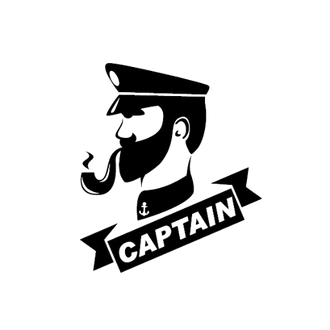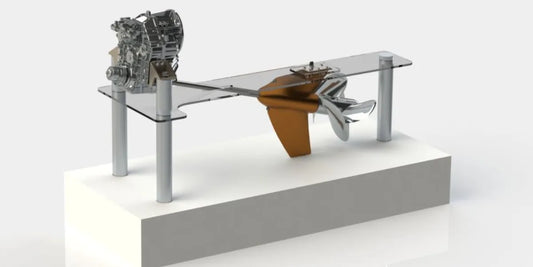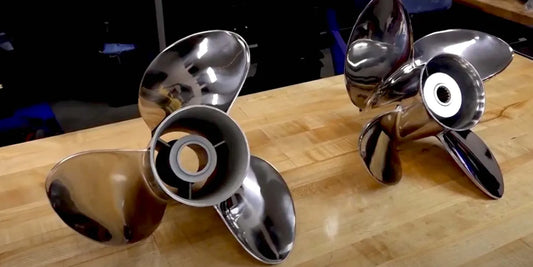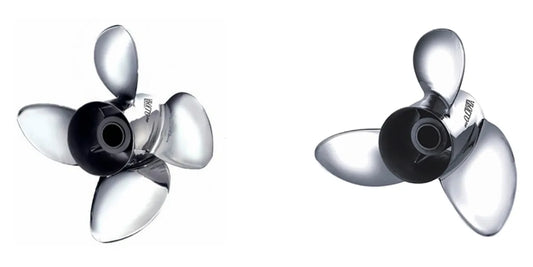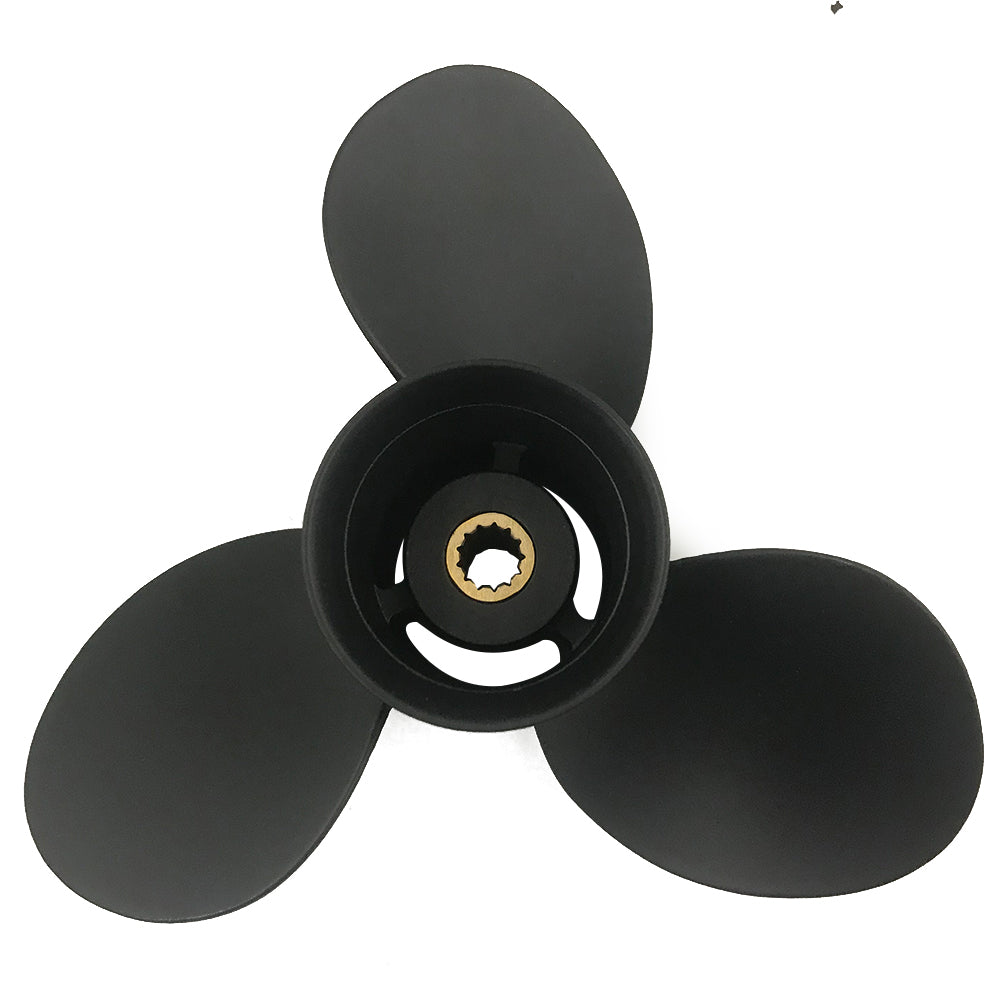Choosing the right propeller for your boat is a decision that can greatly impact your vessel's performance, fuel efficiency, and overall handling on the water. Between the most common choices lie the 3-blade and 4-blade propellers, each with their own set of inherent characteristics and functional use, leaving numerous owners wondering which one will best suit their individual needs. This article will take a technical, performance-based dive into both styles, presenting a side-by-side comparison to help you make a well-informed decision. Whether you want speed or stability or fuel economy, it will be of utmost importance for you to learn the differences of 3-blade vs. 4-blade, so your boating experience will be maximized, and your vessel's capabilities fully explored.
Understanding Propeller Basics

What is a Propeller?
A propeller translates rotational energy into thrust, and this thrust causes movement within a fluid medium such as water or air. It consists of blades mounted around the central hub, and every blade is aerodynamically shaped to create a pressure differential during rotation. This pressure differential, dependent on the direction of rotation, imparts either forward or backward thrust. Factors such as blade count, pitch, diameter, material used for the construction of blades and the speed of rotation of the propeller shaft affect propeller's working. Advancements in the field of hydrodynamics and material engineering now allow for greater propeller efficiency, which in turn makes out very important in the marine and aviation industries, where accurate thrust and energy optimization are of utmost concern.
Types of Propellers: 3-Blade Vs 4-Blade
How about a few comparisons exhibiting performance characteristics, efficiency, and application suitability? Three-blade propellers are typically favored for speed efficiency. The design generates less drag due to lessened surface area of blades; thus, a display application where potential for speed and loss of power through resistance is minimized. Three-bladed propellers are usually more enhanced given that they are lighter, therefore having lesser frontal area as viewed from the front at high velocity.
Conversely, 4-blade propellers thrive in scenarios demanding more thrust and stability. The extra blade allows for a higher surface area to interact with water or air, translating into a better hold, smoother operation, and less cavitation, especially at low speeds. Thus, 4-blade propellers are excellent choices for towing, heavy-load situations, or when working in an environment characterized with a lot of turbulence or resistance. On the flip side, too much surface area can actually drag the prop down by increasing friction, while in a 3-blade propeller, friction eats into top speed.
Choosing between a 3- or 4-blade propeller depends on operational speed, load to be applied, and environmental factors-a way finer nuance function-versatility understanding will assist operators in placing each system at the peak of its capability.
Material Afloat in Propeller Making Industry
Propellers usually come in different types and materials chosen with respect to durability, strength, and behavior during different environmental conditions. The greatest common denominators include:
Aluminum Alloys: Aluminum is preferred on account of its great strength-to-weight ratio and corrosion resistance along with ease of manufacturability. In marine and aviation applications, aluminum is always preferred when performance and cost are major considerations. Modern aluminum alloys are usually alloyed with magnesium or silicon for better mechanical properties.
Stainless Steel: Stainless steel is acknowledged for its better strength and corrosion resistance, which suit environments with great salinity or extreme conditions. Since some of those applications demand a little more weight to offer better strength and the ability to withstand stress, stainless steel has been one good option for those uses that require high performance or commercial."
Composite Materials: Composites are increasingly employed in propeller-making and include carbon fiber or fiberglass-reinforced plastics. They are light in weight yet very strong, which maximizes efficiency while lowering consumption and vibration. Their properties can be manipulated to meet specific aerodynamic or hydrodynamic requirements.
Bronze Alloys: Traditionally used in marine propellers, such alloys of bronze, like manganese bronze or nickel-aluminum bronze, have excellent resistance against corrosion and wear when in contact with salt water. They are quite heavy and are best suited for large vessels where weight is the least of concerns.
Titanium has a low density and possesses fantastic strength and corrosion resistance, ensuring maximum efficiency and reliability. Although its price is substantially above other materials, titanium is mainly used in supra-performing propellers, mainly considered for aerospace or advanced marine applications.
Environmental conditions include load, exposure, and expectations from performance as the operational demands from a propeller material. Further developments in material technologies will continue to enhance propeller efficiency in resisting extreme conditions and maximizing operational efficiency.
Performance Factors of 3-Blade and 4-Blade Props

Speed and Acceleration: A Comparative Study
The broad classification of variables affecting the performance of the 3- and 4-blade propellers in terms of speed and acceleration hinges on aerodynamic and hydrodynamic considerations, as well as those special to the nature of the service. For example, a 3-blade propeller is generally considered to offer a higher top speed than a 4-blade propeller because of its lesser drag force and minimal surface area in front of the air or water. Inherent to such a structure, the resistance is minimized, and thrust efficiency becomes maximized at great velocity; hence, this is the kind of application that pays most attention to speed.
The 4-blade propeller, conversely, provides better acceleration and stability, especially in situations requiring stronger load management or more steady control in operation. With more blade surface to grip, the four-blade propellers provide better thrust at low to medium speed. This type is commonly chosen for occasions where finer maneuverability is called for, such as towing, heavy-lift, or turbulent environments. Sometimes, design and material technology improvements can assist in minimizing these configuration trade-offs so that the engineer can custom-tailor performance features to the needs of the particular operational profile.
Efficiency and Fuel Consumption of Different Blade Configurations
If respectively of efficiency and fuel consumption, they are considered for the choice and optimization of blade configurations, since such parameters bear directly on operational costs and sustainability. Fixed-pitch systems, having a simpler design when compared to the others, operate below the maximum available efficiencies at any operational condition, for the blade angle cannot be adjusted. Variable-pitch and controllable-pitch propellers, however, are better at adjusting to variation in speed and load conditions and hence provide reductions in fuel consumption under such dynamic conditions. From more sophisticated hydrodynamic and aerodynamic simulations, it could be concluded that the optimized pitch angles yield fuel savings of 10-15% depending on the application and environmental conditions.
Additionally, recent advances in computational fluid dynamics (CFD) and real-time monitoring of performance have allowed engineers to optimally configure blades to achieve the best possible balance between efficiency and power output. Material innovations incorporating lightweight composites and friction-lowering coatings have further improved energy efficiency by reducing drag. Conversely, the integration of data analytics with predictive maintenance ensures that wear and fouling of blades are kept to a minimum, thus maintaining peak performance and fuel efficiency over time. These technological innovations emphasize modern design and operational strategies for achieving maximum efficiency in a diverse range of propulsion systems.
Handling and Maneuvering Across the Conditions
Modern propulsion installations whose operational efficiency and safety depend under varied environmental conditions upon handling and maneuverability find improvements of hull design and control system using hydrodynamic analysis and CFD so that they operate uniformly under the entire range of environmental conditions from calm seas to rough turbulent waters.
Adaptive systems such as dynamic positioning and advanced autopilot provide enhanced response and stability so that the vessel can stay along the intended course under high wind or wave loads. Directional control and turning radius can be optimized with thruster and rudder arrangements employing technologies such as high-lift foil designs and azimuth thrusters. Modern maneuvering systems use real-time sensor feedback and predictive algorithms to respond actively to environmental changes, ensuring seamless operation even when safety margins and levels of propulsion stresses get reduced. Such an advancement is evident of continuous pursuit to introduce vessel handling features that provide the assurance of dependability and effectiveness in various maritime conditions.
Choosing the Right Prop for Your Boat

Considerations: Boat Size and Type
Selecting the ideal propeller with all considerations put into perspective and tilted towards a boat's size and type is vital as these two greatly influence the function or performance of a propeller. Big boats with heavy payloads need lower-pitch and bigger-diameter propellers in order to produce adequate thrust to conveniently propel the boat. For smaller and lighter boats, however, propellers with higher pitches may be used to achieve faster speeds while maintaining a nominal engine RPM range.
Different classes of boats bring with them unique and specific performance parameters that define and limit their use as much as any other feature. Fishing boats, for example, would rather go very slowly to pull lots of weight behind them. Speedboats have an emphasis on speed and acceleration. The design parameters of a propeller, such as the shape and number of blades, can therefore be made to fit a specific performance objective so propulsion efficiency and fuel economy can be optimized. Knowledge of the maximum power output of the engine and its general operating range will help elect the best prop, the one most favorable to long life and utility.
How Do You Ride? How Will You Use the Boat?
Evaluating your riding style and the intended use of your gear is a paramount consideration when selecting any equipment or components. Riding style can refer to the terrain preferred, speed anticipated, or frequency of use. For example, if a person frequently rides on paths that are rugged and uneven, they may need components that emphasize durability and shock absorption. Conversely, riders who are all about speed and smooth cruising will want to keep their eye on light materials and aerodynamically shaped designs. The intention of use affects matters differently. For example, components destined for leisure use will vary radically from components meant for competitions or very intensive activities. Based on such considerations, one will be able to ensure that specifications on their equipment match the functional requirements of their particular riding environment. This targeted track of specifying equipment will improve performance while maximizing safety and efficient working.
Expert Recommendations for 3-Blade vs 4-Blade Props
In the decision between 3-blade and 4-blade propellers, operational requirements, vessel characteristics, and performance expectations should be considered. A 3-blade propeller generally attains higher speed due to lesser drag and is thus the better choice for top speed applications, such as high-performance speedboats. Design-wise, it may also be fuel-efficient at cruising speeds-an advantage in long-distance-type operations.
On the other hand, 4-blade propellers offer superior thrust and handling stability in situations that require grip and control, such as rough waters, or during towing. The extra blade surface area aids in carrying more load, which makes them very efficient for extra-heavy applications or vessels wherein low-speed maneuverability is of concern. 4-Blade designs might, however, lose a little maximum speed; this loss in speed is generally well compensated for by the gain in durability and smoother handling where the need for low-precise handling and low engine shock is paramount.
In the end, some detailed assessment relative to the type of vessel, operating conditions, and the desired outcome of performance should be made before deciding on either a 3-blade or a 4-blade configuration.
Installation and Maintenance Tips for Propellers

How to Properly Install a Propeller
The proper installation of a propeller is key for achieving maximum performance, avoiding mechanical failure, and prolonging the life of the propulsion system. The installation involves several critical steps that require careful execution.
Check the Propeller Shaft: Make sure the propeller shaft is clean, free from foreign matter, and shows no sign of damage such as scoring or corrosion. Any imperfection on the shaft could cause improper seating or imbalance during operation.
Apply the Grease: Apply a light coat of marine-grade grease on the propeller shaft. This acts as a lubricant during the propeller installation and prevents excessive wear or corrosion, especially in saltwater environments.
Keyway and Key Alignment: Insert the key into the keyway on the shaft, keeping in mind that it must fit snugly and may not go above a certain height. Proper alignment is crucial since a misaligned key could cause vibration or damage to the shaft and propeller hub.
Propeller Mounting: Afterward, slide the propeller onto the shaft, aligning it with the key. It should fit firmly but without forcing it. Any misfit or forcing might cause damage or hinder performance.
Set the washer and nut: place the thrust washer, after which the nut securing the propeller is fitted. Use a torque wrench to tighten the nut to the manufacturer's specifications, ensuring that it is neither too loose nor overtightened.
Lock the Nut: Lock the nut using either a cotter pin or a locking tab washer, in accordance with your vessel's design. This is to ensure that under operational conditions, the nut doesn't come loose.
Clearance Checks: The possibility of contact between the propeller blades and the hull or other components should be eliminated, because once such an incident occurs, it could result in they being damaged.
The Final Inspection: Check that all components are firmly in place and that the propeller has no excessive play. Proceed to rotate the propeller by hand and verify that it moves smoothly and without hindrance.
When installed correctly, this will ensure good operation and reduce any possibility of problems from cavitation, or vibration, or premature wear that detrimentally affect vessel performance. Hence, operators should fit a propeller and engine in accordance with precise technical requirements as set by the manufacturer in the guidelines specific to that particular propeller and engine model.
Regular Maintenance for Top Performance
Regular and thorough maintenance is required to retain marine-propulsion-system longevity and performance. Operators will need to look over the propeller for any signs of damage-Nicks, cracks, or bends-hence losing hydrodynamic efficiency and leading to higher fuel consumption. Propeller cleaning should be done at intervals to remove marine growth from the surface, such as barnacles or algae, ensuring drag reduction and enabling a thrust level close to the rated one.
Another key element in preventive maintenance is lubrication of moving things, such as the shaft and the bearings of the propeller. The operators need to apply lubricants as recommended by the manufacturer and check the sealing to avoid ingress of water, which leads either to corrosion or mechanical failure. They would also want to ensure checking the alignment of the shaft and setting of torque in order to prevent excessive vibration or imbalance during the operation.
Regular maintenance reduces secondary types of issues that are costly repairs or sudden downtime, always though kept for peak performance. Incorporating inspections and servicing in the procedure enables the operator to uphold the efficiency and reliability of the marine propulsion system.
Common Problems Related to 3-Blade and 4-Blade Propellers
When discussing the common problems with 3-blade and 4-blade propeller systems, it becomes pertinent to talk about respective parameters or considerations such as hydrodynamic efficiency, load distribution, and application-specific performance.
3 Blade Propeller: The most recurrent problem with three-bladed propellers is cavitation, occurring usually in scenarios of high-speed operations of the propeller or occurrences of turbulent water changes. Such instances lead to a situation where efficiency is reduced, more noise is created, and also that surface damages to the blade could be contemplated. Also, unbalanced loading is more adverse in three-bladed designs since this causes vibration, and in particular, in the case of misalignment in either the propeller or the shaft, even if it is of a very little amount. Thus, these things make a three-bladed propeller not quite appropriate for a vessel demanding ultra-smooth operations in a sensitive environment.
4-Blade Propellers: Four-blade propellers have the thrust advantage and smoother ride due to better load distribution. However, drag is usually the problem one faces. A bigger blade surface means increased water resistance; thus, one lower top-end speed can be achieved for the vessel. This goes against the grain for high-performance crafts when speed is of the essence. Another downside to 4-blade installations is increased wear on the drivetrain due to the excess torque needed to sustain superior performance.
The unwanted fouling of a propeller in time could be due to growth of barnacles, algae, and other marine life. Should such a condition occur, performance may degenerate unless checked through regular maintenance. Proper sizing, selection of materials, and ensuring that the selections are compatible with the power rating of the vessel engine would go a long way to mitigate against such problems in both 3-blade and 4-blade propeller configurations.
Real-Life Experiences from Boat Owners

Case Studies: Performance of 3-Blade Propellers Versus 4-Blade Propellers
From my experiences and detailed case studies I have analyzed, the performance differences between three- and four-blade propellers are usually tailored to the specific needs of the vessel and the conditions at hand. For example, there was a test performed on a mid-sized fishing boat in calm and rough water where the 3-blade propeller always generated more top-end speed and better fuel economy. This was because there was less drag now for the one with fewer blades underwater, which allowed it to perform more smoothly at high RPMs. However, when coming down to slow speeds or heavy loads, the boat had a little loss in precise handling compared to with a four-blade one.
In contrast, I have observed boaters with high-performance ski boats or boats designed for towing activities that report an appreciable difference in acceleration and overall stability with the 4-blade propellers-One such occasion was brought about by a wakeboarder who was of the view that there was much better thrust at low speeds, cavitation was lessened, and there was better control in abrupt turns with the 4-blade setup. With the reduction of the 4-blade setup to a small extent in top speed, this was one of the few compromises deemed worthwhile because even in rough waters, the handling and ride felt smoother.
Finally, the decision for a 3-blade vs 4-blade propeller is highly dependent on a boat's operational requirements, engine specifications, and everyday usage. From testing to real-life feedback, it has been deduced that three-blade propellers are meant for applications where speed and efficiency are the priority, whereas four-blade propellers are used where more precision control, heavier loads, and added thrust largely at lower speeds come into the picture. An accurate assessment of these considerations will be paramount to their performance optimization and to produce the best outcome for whichever boating application.
Boat Owners' Feedback on Propeller Choice
"The instant I switched out my 3-blade propeller for a 4-blade one, the change was evident. Because I operate a heavy fishing boat, it made a world of difference in giving the boat better low-speed handling, maneuvering, and control while in tight fishing grounds. The other benefit is that it appears to give a bit more thrust under a heavy load of gear. This means I sacrificed a little bit of top-end speed for great control and fuel economy at cruising speeds. I would definitely recommend a 4-blade prop in a situation like this." - Mike R., seasoned fisherman.
"I have this small pleasure boat, mainly for watersports such as wakeboarding or tubing. After thorough research and actual trials, the 3-blade propeller came in as the best fit for my performance requirements. It provides high-end speeds needed for quick momentum and smooth acceleration, which is constant. Even with a handful of passengers on board, the boat performs extremely well. I did consider a 4-blade option but realized that the added drag and somewhat slower top speed did not suit my needs. The guys use 3-blade props to get the most speed and maneuvering ability on the water." – Sarah L., recreational boater.
These testimonials emphasize how important it is to choose the right propeller custom to your boating needs. Whether a given application requires low-speed control or promises to boost speed and performance, an understanding of prop design and applications could make a vast difference in satisfaction and efficiency afloat.
Reference Sources
3 Blade vs. 4 Blade Propeller - Michigan Wheel
This article explains the differences in performance, pitch, and applications between 3-blade and 4-blade propellers.
3 or 4 Blade Prop is Better for Planing Faster? - Reddit
A discussion on how 4-blade props provide better traction and quicker acceleration but lower top-end speed.
3 or 4 Blade Prop - Boat Talk
Insights into how 3-blade props offer better efficiency and top-end performance compared to 4-blade props.
4 Blade Propeller: Any Noticeable Difference? - Facebook Group
A community discussion on the advantages of 4-blade props, including better balance and reduced vibration.
How 4 Blade vs 3 Blade Boat Propeller Impacts Speed and Efficiency - Buy Propeller
This blog details how 3-blade props reduce drag for higher speed, while 4-blade props enhance stability and handling.
Frequently Asked Questions (FAQs)
How are 3-blade and 4-blade props different?
In reality, these are two worlds in design and performance against the side of 3-blade and 4-blade propellers. The 3-blade prop generally yields a higher top speed since it has lesser drag on itself, whereas the 4-blade prop might accelerate better and might perform better at planing speeds. In other words, if the hook is a short hole shot with better performance at lower rpms, the 4-blade prop would do well. On the other hand, when one wants to achieve higher speeds and efficiency, the 3-blade prop might be more beneficial. Lastly, a 4-bladed one can absorb harsh water conditions a little better, thereby enjoying dual-band popularity among recreational boaters.
How does performance change with the number of blades?
The number of blades on a conical surface has a direct effect on the workings of the boat, including its speed and torque output. A 3-blade propeller usually works with less drag, which can make the boat go faster and give it better fuel mileage at WOT. On the other hand, a 4-blade propeller, with an extra lift, can give more handling and control in rough waters. That extra blade can also help to maintain speed at low rpm, mostly helpful in quick acceleration activities. Depending on the boater's requirements and preferences, either fewer blades or more blades can be considered.
Which is better for fuel efficiency: the 3-blade or the 4-blade propeller?
With fuel efficiency in mind, the choice between a 3-blade and a 4-blade prop depends on the design of the boat and its use. Generally, at slow speeds, a 3-blade prop can be considered less efficient since it has to run at such a high rpm to get the best performance from it; at high speeds, however, it may give the best mileage being that less drag is imposed on the boat. Conversely, at slow speeds the 4-blade is better for fuel economy, as it enables the engine to remain at lower rpms, hence the best possible efficiency. So the ideal prop for fuel efficiency depends largely on what sort of boating conditions you usually find yourself under and, indeed, how you go about operating your boat.
How does blade area come into play when selecting the propeller?
Blade area also plays an essential part in the performance of a propeller in the given operating conditions. A 4-blade propeller will naturally carry more blade area than a 3-blade one and hence is capable of exerting more thrust and more lift, which can help out much in averagely large and medium load vessels. However, more blade drag might be created at higher speed, which will weigh down the 4-blade prop over the 3-blade one as the better pick for assisting in ensuring speed. Hence, the boat owners must look into their hull and the way the boat is usually used to choose whether their requirements will be best served with a 4 or a 3-blade propeller.
Does a 4-blade prop force give more pull at low speeds compared to its 3-blade cousin?
This is because 4-blade propellers have more surface area that can enhance the grip in water as opposed to 3-blade propellers-and that means better acceleration or torque from a standstill. This is why 4-bladed propellers are very popular among water sport activities-where athletes need a strong low-speed pull for skiing or tubing.
However, boaters must evaluate their own needs and conditions since, in some cases, they might see their performance requirements met with 3-blade propellers as well.
What benefits to using 3 bladed props?
Benefits of choosing the 3-bladed propeller include greater top speed and heightened WOT performance. Less blade drag helps the boat hit higher speeds with greater efficiency. The 3-blade props are often said to be a little lighter and may give better mileage under certain conditions. Also, they will tend to be easier to handle at speed, which is great for racing or recreational boating at top speed. In rough water, though, they may not do as well compared to 4-blade props, so the choice is really based on the boating environment and intended use.
